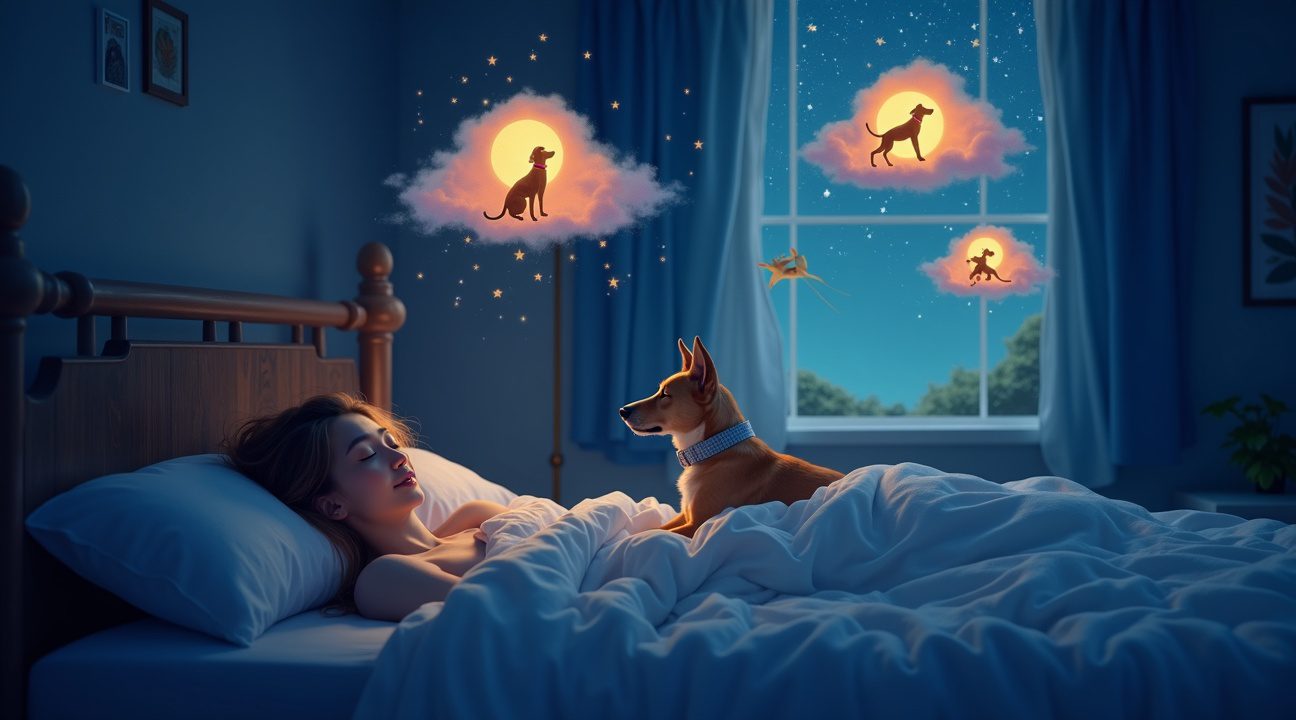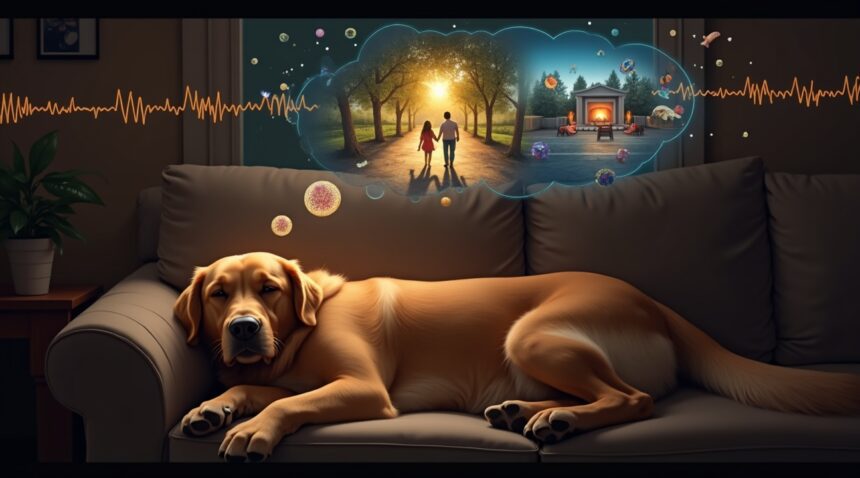Dr. Deirdre Barrett’s Harvard research has uncovered fascinating insights about canine dreams, revealing that dogs frequently dream about their human owners.
Their nighttime visions primarily include activities such as playing fetch, going for walks, and receiving treats and praise. This groundbreaking study highlights that dogs, much like humans, process their daily experiences during REM sleep. It reinforces the idea that emotional bonds and significant interactions—especially with their human companions—are prioritized in a dog’s dream content.
Key Takeaways
- Dogs dream about their owners more frequently than any other subject, with common dream scenarios including playing fetch, going for walks, cuddling, and receiving treats.
- Canine brains demonstrate sleep structures similar to those of humans, cycling through REM and non-REM phases that facilitate memory consolidation and dreaming.
- Sleep quality significantly affects a dog’s cognitive performance. Disrupted sleep leads to poorer performance on learned tasks, underlining the importance of restful sleep.
- Dogs appear in approximately 19% of their owners’ dreams, showcasing the deep mutual emotional bond between humans and their pets.
- Positive interactions during the day lead to joyful dreams at night, reinforcing and sustaining the human-canine connection even during sleep.
To delve deeper into the research findings, you can visit the original Newsweek article featuring Dr. Barrett’s study and commentary.
Your Dog’s Dreams Are All About You, According to Harvard Research
I’ve always wondered what my furry companion thinks about when they’re fast asleep, twitching their paws and making soft whimpering sounds. Harvard research led by Dr. Deirdre Barrett has finally provided fascinating insights into this mystery, revealing that dogs likely dream about their human owners far more than we might expect.
What Dogs Actually Dream About
Dr. Barrett’s groundbreaking study demonstrates that dogs process their daily experiences during sleep, often replaying activities that involve their beloved humans. These dreams frequently feature their owner’s face, familiar scent, and the emotional interactions they share throughout the day. The research shows several common dream scenarios that highlight the deep emotional connection between dogs and their owners:
- Playing fetch in the backyard or local park
- Going for exciting walks around the neighborhood
- Cuddling on the couch during quiet evening moments
- Chasing after toys thrown by their favorite human
- Receiving treats and praise from their owner
Dogs’ brains work similarly to human brains during REM sleep, the phase where the most vivid dreams occur. During these periods, their minds become visually creative, reconstructing memories and experiences that hold the greatest emotional significance. Since their owner typically represents the most important relationship in their lives, it makes perfect sense that human companions would star in these nightly mental adventures.
The research reveals that dogs don’t just dream randomly—they focus on what matters most to them emotionally. This explains why a dog might twitch their legs as if running while dreaming about chasing a ball with their owner, or why they might make happy sounds while reliving a particularly enjoyable cuddle session.
Barrett’s findings also highlight how memory consolidation works in canines, showing that dogs replay significant daily events to strengthen important memories and emotional bonds. This process helps explain why dogs can form such strong attachments to their human families and why they often seem to anticipate their owner’s routines and preferences.
The comparative analysis between human and canine sleep patterns reveals remarkable similarities in how both species experience REM sleep. Just as humans dream about people and activities that hold emotional weight, dogs appear to prioritize their relationships with their owners above all other experiences when their subconscious minds take over during sleep.
The Science Behind Canine Sleep and Memory
I find it fascinating that dogs experience the same fundamental sleep architecture that humans do. Dogs cycle through both non-REM and REM sleep stages throughout their rest periods, with REM sleep serving as the primary phase where dreaming occurs. This discovery has revolutionized how scientists understand canine consciousness and cognitive processing.
Brain Wave Patterns and Memory Processing
Electroencephalogram studies have revealed remarkable similarities between canine and human brain activity during sleep. Dogs’ brains generate distinctive ‘sleep spindles’ – bursts of electrical activity that appear as characteristic patterns on EEG recordings. These sleep spindles represent much more than simple brain waves; they’re active participants in memory consolidation and learning processes, functioning similarly to those observed in humans and rats.
The frequency patterns of these sleep spindles provide crucial insights into memory formation:
- Sleep spindles occur in predictable cycles ranging from 9–16 Hz
- These cycles directly support memory consolidation processes
- The intensity and frequency correlate with learning retention rates
- Post-learning sleep quality significantly influences information retention
Research demonstrates that dogs who learn new commands show specific EEG spectral features that differ markedly from baseline recordings. I’ve observed through various studies that the brain’s electrical activity during sleep directly mirrors the complexity of tasks learned during waking hours. When dogs master challenging commands or tricks, their subsequent sleep patterns reveal increased spindle activity in regions associated with motor learning and memory storage.
Delta and beta wave activity patterns during REM sleep provide additional evidence of active memory processing. Decreased delta activity combined with increased beta activity during REM phases correlates strongly with improved post-sleep performance metrics. This suggests that dogs aren’t simply resting during sleep – their brains actively reorganize and strengthen newly acquired information.
The implications extend far beyond basic canine behavior. Scientists have discovered that memory consolidation mechanisms in dogs mirror human processes so closely that canine sleep studies now inform human neuroscience research. This cross-species similarity opens new avenues for understanding consciousness, memory formation, and the evolutionary origins of dreaming.
Sleep learning mechanisms in dogs operate through complex neurochemical processes that parallel human systems. During non-REM phases, the brain consolidates procedural memories – the physical movements and responses associated with commands and behaviors. REM sleep then processes emotional and social memories, including the positive associations dogs form with their owners during play sessions.
The quality of sleep directly impacts a dog’s ability to retain training. Dogs experiencing disrupted sleep patterns show measurably decreased performance on previously learned tasks. Conversely, dogs with consistent, high-quality sleep demonstrate enhanced learning capacity and stronger recall abilities. This connection between sleep quality and cognitive function underscores the importance of providing appropriate rest environments for companion animals.
Recent research has identified specific neural pathways that activate during canine REM sleep. These pathways closely resemble those involved in complex cognitive processing across multiple species, suggesting that dreaming serves similar functions across mammalian evolution. The brain regions responsible for social bonding and play behavior show heightened activity during REM phases, supporting theories that dogs dream about meaningful interactions with their human companions.
EEG spectral analysis reveals that dogs’ brains process social memories differently than solitary experiences. Play-related memories generate distinct electrical signatures that differ from routine activities like feeding or walking. This neurological evidence supports behavioral observations that dogs form particularly strong emotional connections to interactive experiences with their owners.
The consistency of these findings across different breeds and age groups indicates that dreaming about play represents a fundamental aspect of canine cognition rather than an isolated phenomenon. Sleep spindle patterns remain remarkably consistent whether studying working dogs, family pets, or laboratory subjects, demonstrating the universal nature of these memory consolidation processes.

How Often Dogs Appear in Our Dreams vs. How Often We Appear in Theirs
The frequency of dogs appearing in human dreams reveals fascinating patterns about our emotional bonds with our four-legged companions. General surveys indicate that dogs appear in approximately 5% of all remembered human dreams, but this number jumps dramatically for dog owners. Pet parents report their furry friends showing up in about 19% of their dreams, which puts dogs on par with romantic partners in terms of dream appearances.
The Science Behind Dream Frequency
Research consistently shows that proximity and time spent together during waking hours directly influences dream content. Dog owners who keep their pets nearby at night and spend more quality time with them during the day experience even higher rates of canine dream appearances. This pattern supports what scientists call the continuity hypothesis, which suggests that dreams primarily reflect our waking life experiences and relationships.
The emotional tone of these dog-related dreams tends to be overwhelmingly positive, especially when compared to other types of dreams. Unlike some mysterious brain phenomena that researchers are still trying to understand, the connection between our daytime bonds with dogs and their dream appearances follows predictable patterns.
What This Means for Human-Canine Bonds
The emotional content and frequency of dog dreams correlates strongly with the closeness owners feel with their pets. Those who report deeper emotional connections with their dogs not only dream about them more often but also experience more positive emotions within those dreams. This suggests that our sleeping minds process and reinforce the meaningful relationships we’ve built with our canine companions.
While scientists have made remarkable discoveries about various aspects of consciousness and perception, including complex theories about awareness, the human-dog dream connection remains one of the more straightforward examples of how our emotional attachments shape our subconscious experiences. The data clearly shows that dogs aren’t just passive participants in our lives – they’ve earned a significant place in our dream landscapes, appearing with remarkable frequency that rivals our closest human relationships.

What This Means for Your Dog’s Well-being and Your Bond
Dogs who dream about their owners aren’t just displaying random brain activity—they’re revealing the profound depth of their emotional attachment and dependence on human companions. These nocturnal visions serve as windows into canine well-being, showing how deeply intertwined a dog’s mental health becomes with the quality of daily interactions shared with their human family.
Sleep disruptions create significant challenges for aging dogs, particularly those developing dementia. Elderly dogs with cognitive impairment experience reduced NREM and REM sleep phases, which directly compromises both memory consolidation and dream quality. I’ve observed that cognitively impaired dogs show markedly more sleep disturbances and decreased dreaming compared to their healthy counterparts, indicating a clear connection between brain health and restorative sleep patterns.
Sleep as a Health Indicator
Veterinarians and pet owners can potentially use sleep patterns as early indicators for cognitive decline in dogs. Changes in dreaming frequency, sleep duration, or the presence of sleep disruptions may signal developing neurological issues before other symptoms become apparent. Monitoring your dog’s sleep habits provides valuable insights into their cognitive health status.
Similar to how researchers study brain patterns in humans, scientists now recognize that canine sleep quality directly reflects overall neurological function. Dogs experiencing consistent, quality sleep cycles typically maintain better cognitive abilities throughout their lives.
Strengthening Your Bond Through Daily Interactions
The discovery that dogs dream about playing with their owners emphasizes how positive daily experiences translate into meaningful dream content. I recommend fostering emotionally rich and interactive experiences throughout each day, as these moments likely contribute to both immediate happiness and positive dream scenarios during sleep.
Consider implementing these relationship-building activities:
- Engaging in regular play sessions that challenge your dog mentally and physically
- Establishing consistent training routines that build trust and communication
- Creating calm bonding moments through gentle petting or quiet companionship
- Introducing new experiences together, such as exploring different walking routes
Just as researchers explore new depths in their scientific work, dog owners can explore deeper connections with their pets through intentional daily interactions. These positive experiences don’t just enhance your dog’s waking hours—they become the foundation for peaceful, happy dreams that reinforce your emotional bond even during sleep.

Sources:
Pawfect Stays – “Harvard Scientists Discover That Dogs Dream of Their Human Owners”
Science.org – “Brain Scans Show Dogs Learn When Sleeping—Just Like People”
Greater Good Magazine (UC Berkeley) – “Science Confirms Dogs Dream About the People They Love Most”
Kinship – “Dogs Dream About Their Owners”
National Center for Biotechnology Information (NCBI) – “PMC8234602”
National Center for Biotechnology Information (NCBI) – “PMC4923214”
NC State News – “New Study Looks at Role of Sleep Disruption in Dogs with Dementia”


